Vietnam is a land favored by nature where many different varieties of pomelo can be grown. Some popular types of pomelo that many people love include nam roi pomelo, green skin pomelo, dao pomelo, dien pomelo, doan hung pomelo, phuc trach pomelo, tan trieu pomelo, and luan van pomelo.
However, even if you are a person who loves eating pomelo, it can be difficult for you to distinguish between good and bad pomelo. So if you accidentally fall in love with this type of fruit, learn the following tips on how to choose sweet and juicy pomelos!
1. How to Choose Nam Roi Pomelo
Among all the varieties of pomelo, the nam roi pomelo is the most popular and delicious. This type of pomelo is mainly grown in the southwestern region of Vietnam.
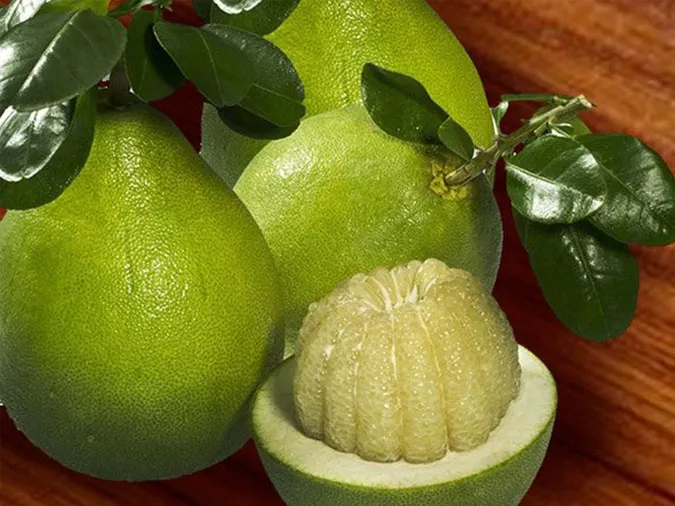
Nam roi pomelo is a specialty of the Mekong Delta (Source: Internet)
To choose sweet and juicy nam roi pomelos, you should pay attention to the following points:
1.1 Pomelo Stem
When looking at the stem of the pomelo, you can determine when the pomelo was picked, whether it is young or old, and even if it is sweet. If the stem of the pomelo is shriveled, it means that the pomelo has been picked for a long time and is old. If the stem of the pomelo is still fresh, it means that the pomelo was just picked.
Note: For nam roi pomelos, they will taste much better after being picked for 1-2 weeks than when eaten right after being picked.
1.2 Pomelo Skin
One of the tips for choosing good pomelos is to look at the skin. The skin of the nam roi pomelo is usually green-yellow and has thorns. If you see these thorns are even and large, it means the pomelo is old. On the contrary, if you see these thorns are quite small and uneven, it means the pomelo is still young.
In addition, you can also use your hand to gently pat the pomelo to feel the thickness of the skin. If you feel the pomelo is firm to the touch but the skin is thin, then the flesh of the pomelo will be very tasty. If the skin of the pomelo is thick, then you cannot determine if the pomelo is sweet or not.
1.3 Weight
Nam roi pomelos have an average weight of over 1kg. Some fruits grown according to the proper procedure may weigh more than 2kg. If the nam roi pomelo is less than 1kg, then you should not buy it.
2. How to Choose Green Skin Pomelo
For green skin pomelos, the selection process is much simpler, but you still need to rely on the skin, stem, and weight of the fruit to choose a good one. Here are some tips to help you choose juicy and sweet green skin pomelos.
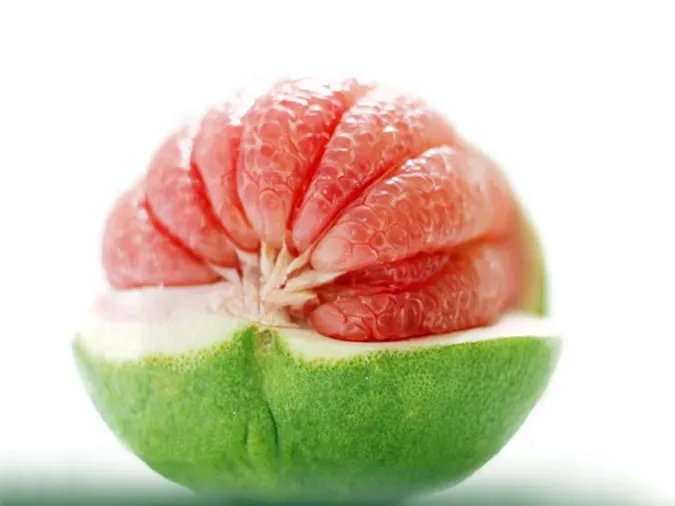
Irresistible green skin pomelo (Source: Internet)
2.1 Weight
Green skin pomelos usually weigh from 1 – 2.5kg. Pomelos weighing less than 1kg are usually only used to make pomelo juice. When buying pomelos, choose those weighing from 1.4 – 1.8kg. Choose fruits that have regular and balanced sizes.
2.2 Pomelo Skin
The skin of the green skin pomelo is greenish-yellow, and the skin is usually taut and not rough. The thorns on the pomelo should be plump and evenly spaced. When you touch it, it should feel smooth.
2.3 Pomelo Stem
Check the stem to assess the freshness of the fruit. It is best to choose pomelos with a fresh stem and fresh leaves. The stem should be firmly attached to the fruit.
3. How to Choose Dien Pomelo
Dien pomelos are usually grown in the northern region of Vietnam, particularly in Phu Tho province. If you want to buy good and authentic Dien pomelos, you need to follow these tips:
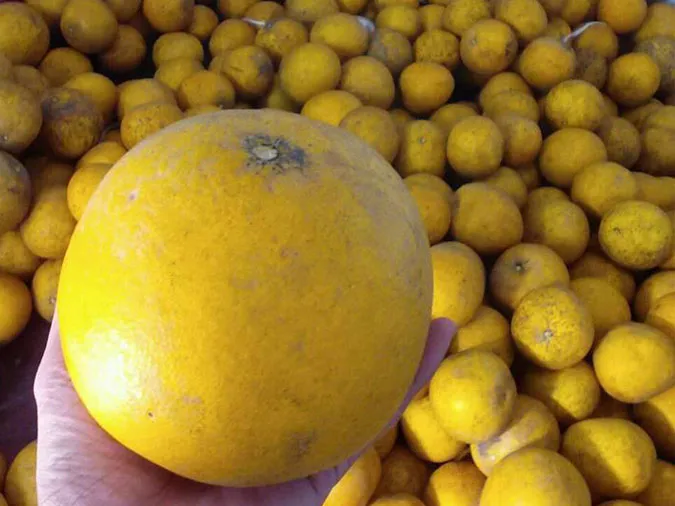
Dien pomelos – a variety of pomelos grown in the northern region (Source: Internet)
3.1 Pomelo Skin
Choose pomelos with slightly bad shape, smooth and shiny skin. Avoid choosing deformed fruits or fruits with damaged skin.
3.2 Weight
Dien pomelos usually weigh between 300g – 1kg. When choosing Dien pomelos, choose fruits with a small size because the characteristic of Dien pomelos is that small fruits are usually sweeter than large fruits.
3.3 Aroma
To choose good and fragrant Dien pomelos, you also need to rely on the aroma of the fruit. Dien pomelos usually have a light, lingering fragrance. Just gently press the fruit and you can feel the softness of the flesh inside.
4. How to Choose Phuc Trach Pomelo
Phuc Trach pomelos are a specialty of Ha Tinh province. Although they have been cultivated in many places, pomelos grown in Ha Tinh have the best taste. Here are the tips for choosing Phuc Trach pomelos:
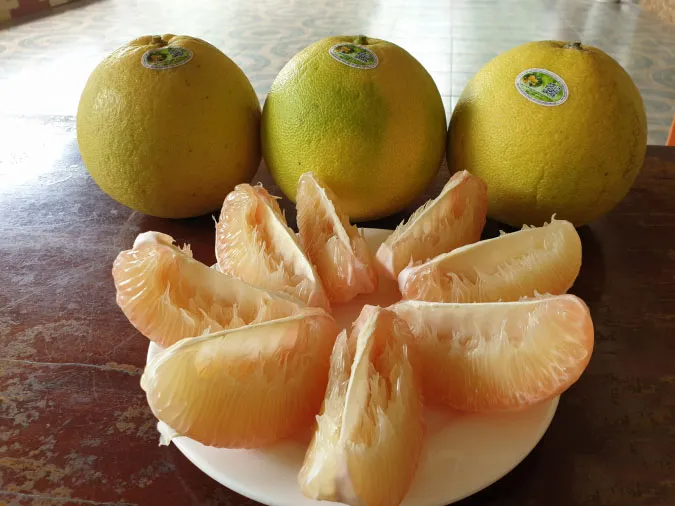
Tips to choose Phuc Trach pomelos (Source: Internet)
4.1 Pomelo Skin
Choose fruits with a round and even shape, smooth and glossy skin. Do not choose deformed fruits or fruits with ugly skin.
The thorns on the pomelo should be large, even. If the thorns are small, it means the pomelo is still young.
4.2 Pomelo Stem
When buying Phuc Trach pomelos, choose fruits with fresh stems. Pressing the pomelo stem should leave a mark.
4.3 Weight
The average weight of Phuc Trach pomelos is from 1 – 1.5kg. Therefore, choose fruits that are moderately large and feel heavy in your hand. Do not choose overly large or small fruits as they will not taste as good.
5. How to Choose Doan Hung Pomelo
Doan Hung pomelos are also a variety of pomelos grown in the northern region of Vietnam, specifically in Phu Tho province. Remember the following characteristics to choose fragrant and delicious Doan Hung pomelos.
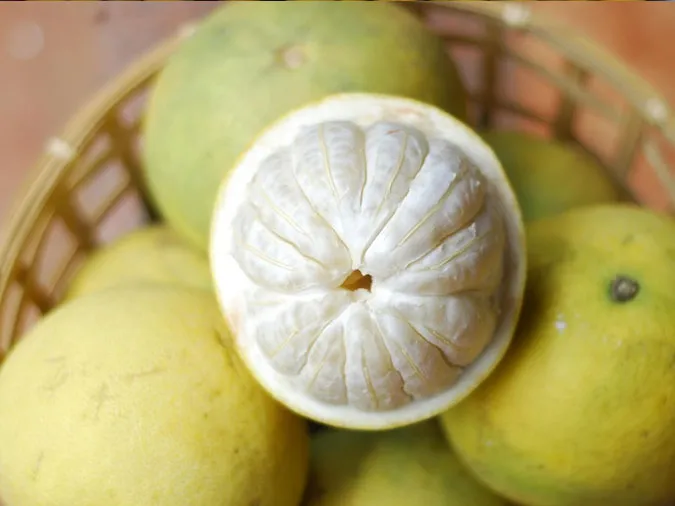
Doan Hung pomelos – a specialty of Phu Tho province (Source: Internet)
5.1 Pomelo Skin
Doan Hung pomelos have a bright yellow skin, smooth and have many thorns (the color of Doan Hung pomelos is quite similar to Dien pomelos). The thorns are used to identify whether the pomelo is ripe or not. If the thorns are large, it indicates that the pomelo is ripe and has sufficient sweetness. If the thorns are small, the pomelo is not ripe yet and usually more acidic.
5.2 Weight
Choose Doan Hung pomelos with a round and flat shape. The weight is usually less than 1kg – medium-sized fruits that are not too large or too small.
5.3 Sound when tapping on the skin
Similar to other types of pomelos, when you gently tap the skin of the Doan Hung pomelo, if you hear a “tach tach” sound, it means the pomelo has thin skin, is juicy, and has a lot of water. On the contrary, if the pomelo makes a “bup bup” sound, it means the skin is thick, there are fewer seeds, and it is not very juicy.
6. How to Choose Dao Pomelo
Dao pomelo is a type of pomelo that ripens later compared to many other pomelo varieties. However, this is also a delicious and popular type of pomelo. Dao pomelo has a sweet, juicy, and slightly sour taste. To choose good Dao pomelos, remember the following characteristics!
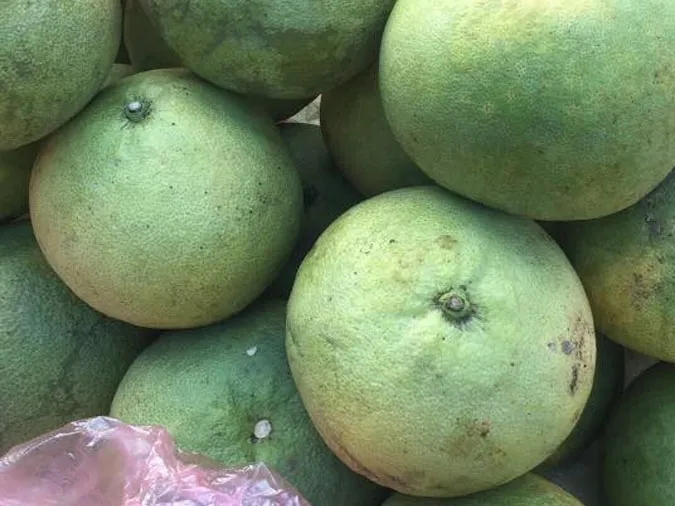
Delicious Dao pomelos (Source: Internet)
6.1 Pomelo Skin
Choose Dao pomelos with bright, plump, and large thorns on the skin. These are signs that the pomelo is ripe and sweet.
When tapping the pomelo with your hand, if you hear a “tach tach” sound, it means the pomelo has thin skin. If you hear a “bup bup” sound, it means the pomelo has thick skin.
6.2 Pomelo Stem
Choose pomelos with fresh stems.
6.3 Weight
A Dao pomelo will have an average weight of 1.2 – 1.4kg.
So with these basic points, you can choose pomelos that are fragrant, juicy, and have a perfect sweet and sour taste for the whole family to enjoy.































